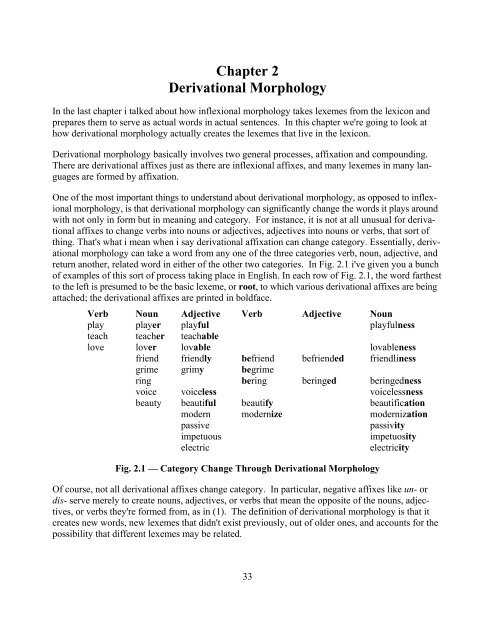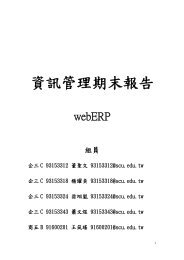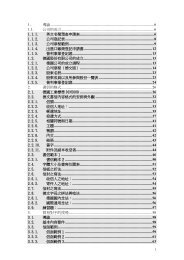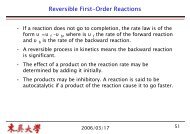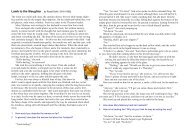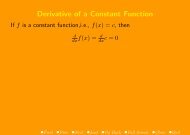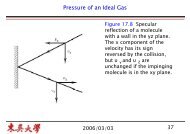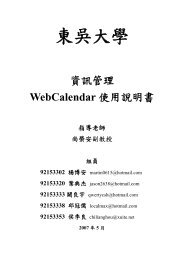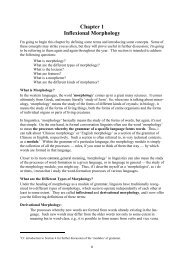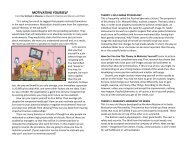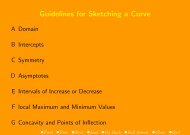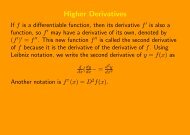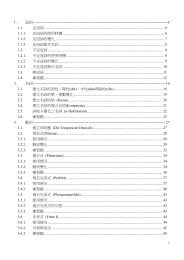Chapter 2: Derivational Morphology (33–53)
Chapter 2: Derivational Morphology (33–53)
Chapter 2: Derivational Morphology (33–53)
You also want an ePaper? Increase the reach of your titles
YUMPU automatically turns print PDFs into web optimized ePapers that Google loves.
<strong>Chapter</strong> 2<br />
<strong>Derivational</strong> <strong>Morphology</strong><br />
In the last chapter i talked about how inflexional morphology takes lexemes from the lexicon and<br />
prepares them to serve as actual words in actual sentences. In this chapter we're going to look at<br />
how derivational morphology actually creates the lexemes that live in the lexicon.<br />
<strong>Derivational</strong> morphology basically involves two general processes, affixation and compounding.<br />
There are derivational affixes just as there are inflexional affixes, and many lexemes in many languages<br />
are formed by affixation.<br />
One of the most important things to understand about derivational morphology, as opposed to inflexional<br />
morphology, is that derivational morphology can significantly change the words it plays around<br />
with not only in form but in meaning and category. For instance, it is not at all unusual for derivational<br />
affixes to change verbs into nouns or adjectives, adjectives into nouns or verbs, that sort of<br />
thing. That's what i mean when i say derivational affixation can change category. Essentially, derivational<br />
morphology can take a word from any one of the three categories verb, noun, adjective, and<br />
return another, related word in either of the other two categories. In Fig. 2.1 i've given you a bunch<br />
of examples of this sort of process taking place in English. In each row of Fig. 2.1, the word farthest<br />
to the left is presumed to be the basic lexeme, or root, to which various derivational affixes are being<br />
attached; the derivational affixes are printed in boldface.<br />
Verb Noun Adjective Verb Adjective Noun<br />
play player playful playfulness<br />
teach teacher teachable<br />
love lover lovable lovableness<br />
friend friendly befriend befriended friendliness<br />
grime grimy begrime<br />
ring bering beringed beringedness<br />
voice voiceless voicelessness<br />
beauty beautiful beautify beautification<br />
modern modernize modernization<br />
passive passivity<br />
impetuous impetuosity<br />
electric electricity<br />
Fig. 2.1 — Category Change Through <strong>Derivational</strong> <strong>Morphology</strong><br />
Of course, not all derivational affixes change category. In particular, negative affixes like un- or<br />
dis- serve merely to create nouns, adjectives, or verbs that mean the opposite of the nouns, adjectives,<br />
or verbs they're formed from, as in (1). The definition of derivational morphology is that it<br />
creates new words, new lexemes that didn't exist previously, out of older ones, and accounts for the<br />
possibility that different lexemes may be related.<br />
33
(1) belief unbelief clear unclear<br />
interesting uninteresting understand misunderstand<br />
interested disinterested respect disrespect<br />
obey disobey legal illegal<br />
Roots vs. Stems<br />
In <strong>Chapter</strong> 1 i talked about stems, explaining that a stem is a lexeme to which inflexional affixes can<br />
be added to produce word-tokens. In this chapter, as already noted, we are looking at how lexemes —<br />
stems — can be formed and added to the lexicon.<br />
From the point of view of inflexional morphology, a stem is basic; you take the stem as it is stored<br />
in the lexicon and add inflexional affixes — prefixes, suffixes, infixes, circumfixes, whatever — to<br />
it. Inflexional morphology is (usually) not interested in the internal structure of the stem to which it<br />
is attaching affixes. This is a little bit like saying that to a chemist, atoms are basic; the chemist is interested<br />
in how whole atoms can be combined with each other. To the physicist, however, an atom<br />
is not basic; it's a combination of a nucleus consisting of protons, neutrons, etc., and a number of<br />
electrons surrounding the nucleus. Likewise, while from the point of view of inflexional morphology<br />
a stem, a lexeme, may be basic, that lexeme may very well have internal structure which, while totally<br />
irrelevant to inflexional morphology, may be of some importance to derivational morphology.<br />
In which case, from the point of view of derivational morphology a stem is not basic. What is basic<br />
to derivational morphology is called a root.<br />
The relationship between derivational and inflexional morphology can perhaps be described in terms<br />
of a flowchart-type diagram such as that in Fig. 2.2. The processes of derivational morphology may<br />
root<br />
<strong>Derivational</strong><br />
<strong>Morphology</strong><br />
stems/lexemes/lexical words<br />
Inflexional<br />
<strong>Morphology</strong><br />
w o r d - t o k e n s<br />
Fig. 2.2 — <strong>Derivational</strong> & Inflexional <strong>Morphology</strong><br />
34
take a single morpheme — a root — and derive any number of lexemes from it. These derived lexemes<br />
can then serve as stems for the processes of inflexional morphology, which can add various<br />
inflexional affixes to them to provide the word-tokens we need in ordinary language use.<br />
It is perfectly possible for a lexeme to be both a stem and a root. We noted in the last chapter that<br />
words such as those in (2a) constitute single morphemes. These are lexemes and stems; as noted in<br />
<strong>Chapter</strong> 1, they readily accept the appropriate inflexional morphemes such as the plural marker -s as<br />
in (2b). They can also serve as roots for derivational processes forming words such as those in (2c)<br />
But it's impossible to analyze them into any simpler morphemes; each of them is a single morpheme<br />
on its own. Therefore, it is also a root.<br />
(2) a. cat dog horse boy book bike<br />
b. cats dogs horses boys books bikes<br />
c. cattiness doghouse horseface boyhood bookish bike path<br />
ungraciousness<br />
un- prefix; negative<br />
grace root<br />
-ious suffix; derives adjectives from nouns<br />
-ness suffix; derives abstract nouns from adjectives<br />
indecipherability<br />
in- prefix; negative<br />
de- prefix; forms verbs of reversal<br />
cipher root<br />
-able suffix; derives adjectives from verbs<br />
-ity suffix; derives abstract nouns from adjectives<br />
antidisestablishmentarianism<br />
anti- prefix; ‘against’<br />
dis- prefix; ‘remove, reverse’<br />
establish root<br />
-ment suffix; derives abstract nouns from verbs<br />
-ary suffix; derives adjectives from nouns<br />
-an suffix; derives a noun referring to a person associated with the meaning of the stem<br />
-ism suffix; derives an abstract noun referring to a political or similar ideology<br />
unmicrowaveability<br />
un- prefix; negative<br />
microwave root<br />
-able suffix; derives adjectives from verbs<br />
-ity suffix; derives abstract nouns from adjectives<br />
Fig. 2.3 — Some Complex Derived English Stems<br />
35
On the other hand, in a language like English some lexemes can be morphologically quite complex.<br />
Witness the words in Fig. 2.3. 1 In each of these four examples, i have highlighted one morpheme<br />
by printing it in boldface and labelling it ‘root’; this is in each case the root underlying the underlined<br />
lexeme above it.<br />
There are a few things that i particularly want to point out in connection with these examples of<br />
complex lexemes. One is that, in the analysis of ‘antidisestablishmentarianism’, in my short note<br />
explaining the use of the suffix -an, i mention the ‘stem’. This is in reference to the stem to which<br />
the suffix is attached; in this case, ‘antidisestablishmentary’. The status ‘stem’ — like the synonymous<br />
status ‘lexeme’ — belongs not only to the underlined words, the final result of (in these cases)<br />
fairly extended derivational processes; it can be used for any stage in the sequence. As already indicated,<br />
a root may itself qualify as a stem. The addition of each derivational affix creates a new stem,<br />
to which new derivational affixes can be added. Of course, if each of these, including the root itself,<br />
qualifies as a stem, this implies that it should be possible to attach inflexional affixes to them as well.<br />
This is, in theory, true; it's limited only by the admitted fact that English has relatively little in the<br />
way of inflexional morphology. I've tried to demonstrate the kinds of possibilities implicit in this<br />
approach by the derivational field shown in Fig. 2.4, 2 which includes some inflected forms (indicated<br />
by the broken arrows) of the stems in question.<br />
ungracefulnesses ungracefulness ungracefully<br />
ungraceful gracefully gracefulness gracefulnesses<br />
disgracefulnesses disgraces graceful graces<br />
disgracefulness grace's gracelessly<br />
disgraceful disgrace (N) GRACE graceless<br />
disgracefully disgrace (V) grace (V) gracelessness<br />
disgraced disgracing graced graces gracing<br />
disgraces gracious gracelessnesses<br />
ungracious graciously graciousness<br />
ungraciousnesses ungraciousness ungraciously graciousnesses<br />
Fig. 2.4 — Derivatives of a Single Root<br />
1 Some adopted, with thanks, from Steven Pinker's The Language Instinct: How the Mind Creates Language (William<br />
Morrow: 1994), p.129.<br />
2 Adapted from J. Tournier's Introduction descriptive à la lexicogénétique de l'anglais contemporaine (Champion-<br />
Slatkine: 1985).<br />
36
↓↓↓隨便↓↓↓隨便↓↓↓隨便↓↓↓隨便↓↓↓隨便↓↓↓隨便↓↓↓隨便↓↓↓隨便↓↓↓隨便↓↓↓<br />
I have said that the difference between a root and a stem is that, while a stem may incorporate any<br />
number of morphemes, a root is by definition a single morpheme and therefore cannot be broken<br />
down into smaller morphemes.<br />
It is sometimes debatable whether a given lexeme can or cannot be broken down into smaller morphemes.<br />
Consider, to take an example from Fig. 2.3, the word ‘microwave’. In Fig. 2.3, i identified<br />
this word as the root of the noun ‘unmicrowavability’. But is ‘microwave’ really a single morpheme?<br />
From the point of view of etymology, that is, the history of the word, it can be analyzed into two<br />
smaller parts, the prefix ‘micro-’ meaning ‘small’ and the word ‘wave’. In this case, ‘wave’ has the<br />
same meaning (波) that it has in the expressions ‘radio wave’ or ‘light wave’: a type of electromagnetic<br />
radiation (電磁輻射). Microwaves are called ‘microwaves’ because they are shorter than ordinary<br />
radio waves (it's all relative, of course; they're still quite a bit longer than light waves). So isn't<br />
it more correct to say that in this case the root is really ‘wave’, with the stem ‘microwave’ being derived<br />
from it by the addition of the prefix ‘micro-’?<br />
Historically, this would be quite correct. But we're not concerned here with the history of the word.<br />
Matters of language history will come up in Part II, in Section 9, the very last section of this book.<br />
Here in this first part of the book, i'm concerned primarily with how language lives and functions<br />
within the minds of its individual users. And to the best of my knowledge, most English speakers<br />
do not tend to think of microwaves as a kind of ‘wave’, or of the word ‘microwave’ as being derived<br />
from the word ‘wave’. For most English speakers, in fact, the noun ‘microwave’ refers not to a type<br />
of electromagnetic radiation but to a machine that lives in one's kitchen; and the verb ‘microwave’<br />
refers to the act of using this machine to warm up one's food. And it is specifically from the verb<br />
that the noun ‘unmicrowavability’ is derived; it means the quality of being unsuitable for microwaving,<br />
for warming up in a microwave oven.<br />
↑↑↑隨便↑↑↑隨便↑↑↑隨便↑↑↑隨便↑↑↑隨便↑↑↑隨便↑↑↑隨便↑↑↑隨便↑↑↑隨便↑↑↑<br />
The analyses i've given in Fig. 2.3 are pretty one-dimensional; they tell you that these words are<br />
formed from the morphemes given and that these morphemes occur in a certain order, left to right,<br />
but they say nothing about the order in which the derivational affixes are actually added to previous<br />
stems or in which each sequence of complex stems is built up. We will have more to say about the<br />
details of how complex lexemes are composed in <strong>Chapter</strong> 10, but for the moment i will show you in<br />
Fig. 2.5 the sequence of derivation of one of the words in Fig. 2.3. Each line in Fig. 2.5 represents a<br />
distinct lexeme, a distinct stem, derived from the stem above it by the addition of the affix indicated<br />
by the plus (+) sign; there are good reasons for believing that, in the derivation of ‘undecipherability’,<br />
the affixes are added in precisely this order.<br />
37
cipher a secret code; writing a message in code<br />
de+cipher recover a plain text from a coded message<br />
decipher+able able to be deciphered<br />
in+decipherable impossible to decipher<br />
indecipherabil+ity the quality of being indecipherable<br />
Fig. 2.5 — Sequence of Derivation of a Complex Stem<br />
Another way of representing this analysis is by means of the tree diagram in Fig. 2.6, in which the<br />
addition of each derivational affix results in a new node which is labelled with the part of speech (N<br />
for ‘noun’, A for ‘adjective’, V for ‘verb’) that results from the addition of that affix. At the lowest<br />
level, i have labelled the root ‘cipher’ as both a noun and a verb; this is because, at least historically,<br />
the verb ‘cipher’ (譯成密碼) is based directly on the noun ‘cipher’ (密碼). The topmost node is<br />
labelled ‘N’, indicating that ‘indecipherability’ is a noun. Tree diagrams are very useful in many<br />
branches of linguistics; we'll see more of them in <strong>Chapter</strong>s 8 and 22.<br />
A<br />
V<br />
V<br />
N<br />
in- de- cipher -able -ity<br />
A<br />
Fig. 2.6 — Tree-Diagram Analysis of a Complex Stem<br />
Productivity<br />
An important issue with derivational affixes is their degree of productivity. Some affixes are more<br />
productive than others, meaning they are used more freely. What does that mean, you may ask. Does<br />
it mean that productive affixes are used in more words than non-productive ones? Sometimes this<br />
is true; however, a more important distinction has to do with the difference (already mentioned with<br />
regard to the analysis of possible roots) between history and current usage: More productive affixes<br />
can still be used to create new words today, while less productive ones may have been used in the<br />
past to create a lot of words, but aren't used much any longer.<br />
For instance, in English we have a number of suffixes that form abstract nouns from more concrete<br />
nouns or adjectives. Some of these are -ness, -ity, and -hood. In the right-hand column of Fig. 2.1<br />
you see some examples of -ness, such as ‘playfulness’, and ‘lovableness’; you also see some examples<br />
of -ity, such as ‘impetuousity’ and ‘electricity’; ‘productivity’ itself is also an example, of course.<br />
In (3) i give you some examples of -hood; but actually, there aren't a lot of words made with -hood<br />
38<br />
N
in modern English, and most of those that are have been around for awhile. We don't use the suffix<br />
-hood much to create new words, at least not in the dialects of English i'm most familiar with. In<br />
technical terms, it is not as productive as -ness or -ity.<br />
(3) manhood neighbourhood parenthood personhood<br />
There are limits on the productivity of the suffix -ity; although it generally converts adjectives into<br />
nouns, as in the examples in (4), there are some adjectives to which it will not attach. For instance,<br />
as shown in (5) there is no word ‘*fiercity’ from ‘fierce’, although ‘fierceness’ is not only a possible<br />
but an actual English word. Part of the problem with ‘*fiercity’ is that there is already an English<br />
word ‘ferocity’, formed by the suffix -ity from a root very close to ‘fierce’, that means exactly what<br />
‘*fiercity’ would mean if there were such a word. I would say that ‘-ity’ is a suffix that was more<br />
productive at a certain time in the past than it is now, and most of the English words that include it<br />
were coined at a time when it was more productive. 3<br />
(4) a. scarce scarcity<br />
b. sincere sincerity<br />
(5) fierce *fiercity fierceness ferocity<br />
On the other hand, some derivational affixes are extremely productive. -ness is definitely one of the<br />
more productive affixes in Modern English. Another is the suffix -er, added to verbs to form nouns<br />
meaning ‘person who does’ the action referred to by the verbal stem. These nouns are called ‘agentive<br />
nouns’ or ‘agent nouns’. I've given you a bunch of examples in (6), together with the verbs from<br />
which they're derived.<br />
(6) Verb Agentive Noun Verb Agentive Noun<br />
write writer kill killer<br />
play player win winner<br />
run runner farm farmer<br />
open opener scrape scraper<br />
xerox xeroxer<br />
The real point of (6) is not just the relatively large number of words in English that are formed using<br />
the suffix -er. It's that new ones are being added to this list quite frequently. There are at most a<br />
very few verbs in English that cannot take the suffix -er — i think i would have trouble accepting<br />
words like ‘*be-er’, ‘*have-er’, ‘*can-er’. 4 But apart from this very limited set of exceptions, as far<br />
as i can tell, once you know that something is a verb you know that the suffix -er can be added to it<br />
3 A few years ago i tried to coin the word ‘baroquity’ from the adjective ‘baroque’; several of the people i tried this word<br />
out on were uncomfortable with it, although i still like it.<br />
4 The words ‘caner’ and ‘canner’ do exist in English, but they are not derived from the modal verb ‘can’. ‘Canner’ is<br />
derived from a different verb ‘can’ that is itself ultimately derived from the noun ‘can’ referring to a metal container for<br />
food. To can something is to be put it in a can, and a canner would be someone (or, possibly, a machine) that does this.<br />
‘Caner’ derives ultimately from the noun ‘cane’ (藤) through a verb ‘cane’ that refers either to the making of furniture<br />
with cane or the use of cane as an instrument of punishment.<br />
39
to form an agent noun. There's an example of this sort of thing at the bottom of the left-hand side of<br />
the list in (6). Xerox is the name of a company that makes photocopy machines. Their photocopy<br />
machines have justly become so famous that nowadays — much to the Xerox company's chagrin —<br />
a lot of English speakers use the word ‘xerox’ to refer not just to a photocopy machine made by the<br />
Xerox company but to any photocopy machine. And the word has become a verb; we often say ‘to<br />
xerox’ meaning ‘to photocopy’. Now, as soon as xerox became a verb, it became possible to have a<br />
noun xeroxer, meaning usually ‘the person in our office who is responsible for doing all the photocopying’,<br />
often also meaning ‘the person who is responsible for taking care of the photocopy machine’.<br />
And indeed it is so; the word exists, and as far as i know began to be used not long after<br />
xerox began being used as a verb.<br />
Affixes like -ness and -er are so productive that one is apt to find a new word using one or another<br />
of them any day. Another example is the suffix -ize, used to form verbs, usually from adjective<br />
stems. Recently i was reading a brochure and came across the word ‘cyrillicize’, meaning to convert<br />
the spelling of some word, typically a name, into the Cyrillic alphabet used in Russia and other<br />
Eastern European countries. Although i've had plenty of opportunity, i don't remember ever seeing<br />
this verb before, and i suspect the writer made it up on the spot. Yet it was immediately obvious to<br />
me what was meant. That's the power of a highly productive derivational suffix like -ize.<br />
Some derivational processes are so productive that (rather like the verbs in incorporating languages<br />
that we looked at at the end of the last chapter) they can swallow up whole phrases as well as words.<br />
This is what seems to be happening in the passage in (7), quoted from Lewis Carroll's Through the<br />
Looking Glass. During a conversation with my wife, i came up with the word ‘unputdownability’,<br />
meaning a quality manifest by a book that is so exciting or interesting that you are unable or unwilling<br />
to put it down. I've provided in (8) a tree-diagram analysis of this word, in the manner used in Fig.<br />
2.6. As i hope is clear from this analysis, ‘unputdownability’ is derived from the complex verb ‘put<br />
down’<br />
(7) ‘What is an un-birthday present?’ N<br />
‘A present given when it isn't your birthday, of course.’<br />
A<br />
(8) unputdownability A<br />
V<br />
un- put down -able -ity<br />
I experienced a more extreme example of this kind of thing a few weeks before i left the States to<br />
come to Taiwan in 1997. I came home from some errand to find our landlady ((女)房東) busy<br />
about our yard. When i asked her what she was doing, she said, ‘I'm de-dead-branchifying this tree.’<br />
Now, in saying that, she was creating a new word on the model of the established Modern English<br />
word ‘de-icing’ or ‘de-ice’, which means to remove the ice, usually from a car or a road. This verb<br />
is formed by the negative prefix de-, which not only means ‘not’ but, especially when attached to<br />
verbs, means ‘remove, take away’. But note that, although ‘ice’ is usually a noun in English, it is<br />
also a verb; we can ‘ice a cake’, and, more appropriately, we can ‘ice’ something by freezing it. So,<br />
like ‘cipher’ in Fig. 2.6, ‘ice’ is already a verb before receiving the negative prefix de-. ‘Dead branch’,<br />
40
on the other hand, isn't a verb; it's not even a word; it's a noun with a modifying adjective — what in<br />
the tree-diagram in (9) i have labelled ‘N′’. 5 So what my landlady did was to convert that whole<br />
phrase into a verb by means of the highly productive suffix -ify, then add to that rather complex verb<br />
the prefix de-, to get a very complex expression meaning ‘to remove the dead branches from’. 6 Now<br />
bear in mind, our landlady is not a linguist. She's a very intelligent and well-educated person who<br />
likes to play word-games, but she's not, so to speak, a professional at it as i am. But this kind of<br />
trick works for her as well as it would for me. This is just another example of how creatively we<br />
human beings — all of us — use language.<br />
(9) ‘I'm de-dead branch-ifying this tree.’ V<br />
N′<br />
V<br />
de- dead branch -ify<br />
↓↓↓隨便↓↓↓隨便↓↓↓隨便↓↓↓隨便↓↓↓隨便↓↓↓隨便↓↓↓隨便↓↓↓隨便↓↓↓隨便↓↓↓<br />
Backformation<br />
Another indication of the creative power of productivity is a phenomenon called backformation.<br />
This is a historical process and in that sense perhaps belongs more properly when we talk about the<br />
history of languages and how and why languages change in Section 9. But i'm going to mention it<br />
here. Backformation is essentially the reversal of a productive derivational process; it involves taking<br />
a word that already exists in the language and that at least appears on the surface to include a<br />
derivational affix, and removing that affix to reveal an apparently simpler word that nevertheless<br />
hasn't existed in the language previously. I've got some examples in (10). Notice that what we have<br />
here are pairs of verbs and what at least appear to be agent nouns derived from them. But in each<br />
case the agent noun has been around longer, at least in English. In some cases, the agent noun really<br />
was derived from the indicated verb — but not in English; rather, the derivation happened in some<br />
other language which happened to have the same, or nearly the same, agentive suffix -er. In other<br />
cases, such as ‘burglar’, the noun in question was not derived from any verb at all.<br />
(10) Verb Agentive noun Verb Agentive Noun<br />
peddle pedlar beg beggar<br />
hawk hawker scavenge scavenger<br />
swindle swindler edit editor<br />
burgle burglar sculpt sculptor<br />
lase laser<br />
5 Technically, that's called an ‘N-bar’, but you don't need to know that.<br />
6 I immediately told her that sentence was going into this text.<br />
41
Most of these nouns came into English many centuries ago, and their associated verbs were formed<br />
some time later and added to the language's vocabulary. But the last entry in the left-hand column<br />
is an interesting case of a similar process happening within the past half century. The word ‘laser’<br />
is what's properly referred to as an acronym, a word made up of the initials of a longer expression,<br />
as shown in (11). Laser technology developed in the late 50's and early 60's, and that's how old this<br />
word is. As you can see from (11), the last two letters of the word ‘laser’ have nothing to do, at<br />
least as far as their origin is concerned, with the agentive suffix -er. That doesn't matter. Once the<br />
word was settled into the English language by the mid-60's, there was really nothing to stop people<br />
who design and work with lasers to come up with a verb ‘lase’, as in ‘this gas lases well’, meaning<br />
when properly treated it will efficiently generate a beam of coherent light, a laser-beam.<br />
(11) Light Amplification by Stimulated Emission of Radiation = ‘laser’<br />
The examples in (10), therefore, are presented in a manner that is not true to their history; the layout<br />
in (10) suggests that the nouns were formed from the verbs, whereas in fact historically the opposite<br />
is the case. In (12) i've given you some further examples of backformation in English with the true<br />
historical process more correctly displayed. Again, we have a set of nouns, each of which ends with<br />
what most English speakers would unhesitatingly recognize as a productive derivative affix, in this<br />
case the suffix -ion as in ‘institution’ or ‘contribution’ or ‘formation’. And, because of this parallel,<br />
English speakers have seen fit to treat the verbs in (12) as legitimate verbs and as the stems from<br />
which these nouns are derived. Now, legitimate verbs they are; we use them all, and if the community<br />
of English speakers says they're legitimate then no one can disagree with us. But they aren't the<br />
stems from which these nouns are derived; quite the contrary, at least as far as English is concerned.<br />
As mentioned earlier, some of these -ion nouns are in fact derived from verbs, but in some other language.<br />
For instance, ‘resurrection’ comes to English ultimately from Latin, which has a derivational<br />
suffix something like -ion, 7 and in that language the noun ‘resurrection’ actually was derived from a<br />
verb ‘resurrex’, meaning roughly ‘to stand up again’. But the English verb ‘resurrect’ did not come<br />
directly from Latin or any other language; it was derived in English by the removal of what appeared<br />
to be a derivational affix. Some of the other verbs in this list, such as ‘electrocute’, ‘televise’, and<br />
‘emote’ are much more recent than ‘resurrect’, indicating that this process continues in our own time.<br />
(12) Noun Backformed Verb Noun Backformed Verb<br />
resurrection resurrect vivisection vivisect<br />
electrocution electrocute television televise<br />
emotion emote donation donate<br />
backformation backform<br />
The last entry in the left-hand column in (12) is included as a commentary from a professional linguist<br />
both on backformation and on my profession. Among linguists specializing in this kind of<br />
thing, you can increasingly hear the use of the verb ‘backform’. But ‘backformation’ is not derived<br />
from any such verb. ‘Backformation’ is derived from the word ‘formation’ by the prefix ‘back’. It's<br />
true that ‘formation’ itself is derived from a verb ‘form’, but the prefix ‘back’ was never attached<br />
directly to the verb ‘form’ to form ‘backform’. ‘Backform’ is derived from ‘backformation’, which<br />
7 Actually, it's more like -tion.<br />
42
itself is of course a piece of technical jargon in linguistics just as ‘laser’ is a piece of technical jargon<br />
in physics and technology, and so in both cases the derived verb is even more a piece of technical<br />
jargon.<br />
Just as another example of backformation in the history of English, this one involving an apparent<br />
inflexional affix instead of a derivational one, i offer you the progression in (13). Back in the Middle<br />
Ages there was no word ‘pea’ in English referring to a kind of vegetable. Instead, there was the word<br />
‘pease’, which referred to a collection of the little green spheres that this plant produces; you'd have<br />
a bowl or a basket of these little things, and the whole thing was called ‘pease’. Eventually, that<br />
word was reinterpreted as a plural involving the usual English plural suffix -s, which invited us to<br />
come up with the singular form ‘pea’ to refer to each individual kernal.<br />
(13) pease > peas > pea (豌豆)<br />
In spite of what i've said, backformation is neither regular nor completely productive. The processes<br />
shown in (14) have never taken place. 8 Which is interesting because, like ‘resurrection’, these<br />
words really were derived from verbs by means of the -able suffix — but not in English. Unless i'm<br />
much mistaken, ‘malleable’ and ‘feasible’ came from French; French has a derivational suffix almost<br />
identical to the English -able 9 and at least at one time French had verbs from which these two<br />
adjectives were derived. But English borrowed the adjectives, not the verbs, and has never bothered<br />
to coin the verbs.<br />
(14) malleable ‘可鍛’ *malley<br />
feasible ‘可行’ *fease<br />
The point of this discussion of backformation here is that backformation depends on the recognition<br />
of productivity. Because it's so easy to form new words by the addition (in English) of affixes like<br />
-able, in-, -ness, de-, and -er, English-speakers tend to assume when they encounter a word that<br />
seems to include one of these affixes that the stem resulting from the deletion of that affix must also<br />
be a legitimate lexeme in the language. But this can only happen if English-speakers recognize<br />
these affixes and others like them as particularly productive, as freely attachable (and, by extension,<br />
detachable) to any stems that meet their conditions.<br />
↑↑↑隨便↑↑↑隨便↑↑↑隨便↑↑↑隨便↑↑↑隨便↑↑↑隨便↑↑↑隨便↑↑↑隨便↑↑↑隨便↑↑↑<br />
Limits on Productivity<br />
No matter how productive they may be, however, derivational affixes usually have some constraint<br />
on their application. Typically, a derivational affix can only attached to a certain kind of stem; for<br />
instance, -ness can only be attached to adjectives. And there are restrictions that are narrower than<br />
that. Let's look at (15) and consider the suffix -able, which forms adjectives out of verbs. -able is<br />
8 I've given you Chinese equivalents of the adjectives ‘malleable’ and ‘feasible’, in case you're not acquainted with these<br />
words.<br />
9 In fact, we got the suffix itself from French, as we shall see in <strong>Chapter</strong> 23.<br />
43
extremely productive. You can see in (15) that there are many adjectives formed with it. If you<br />
look down at the bottom of the left-hand column, you will see that it is approximately as productive<br />
as the agent-noun suffix -er, which as mentioned in connection with (6) could be added freely even<br />
to a brand new verb like ‘xerox’. ‘Fleeb’ is not a word in actual English. But there is experimental<br />
evidence to show that, if you take a bunch of English-speaking children and introduce them to the<br />
imaginary word ‘fleeb’ in a context that lets them know that it's a verb, they immediately understand<br />
that, if ‘fleeb’ is a verb, than ‘fleebable’ is a perfectly legitimate adjective. This is the standard test<br />
for the maximal degree of productivity for a derivational affix.<br />
(15) Verb Adjective Verb Adjective<br />
read readable wash washable<br />
break breakable drink drinkable<br />
move movable dye dyable<br />
fleeb fleebable<br />
But now consider the cases in (16). It is impossible to derive adjectives from the verbs in (16) by<br />
means of the suffix -able — that's what the stars mean; they mean that the forms ‘diable’, ‘cryable’,<br />
‘goable’, and ‘sleepable’ are not acceptable English words, even though they're formed in exactly<br />
the same way as the perfectly acceptable adjectives in (15). 10 What's wrong with the verbs in (16),<br />
or with the suffix -able that it can't attach to them?<br />
(16) die *diable go *goable<br />
cry *cryable sleep *sleepable<br />
The answer, as far as anyone has been able to tell, is that -able is a suffix that forms adjectives out<br />
of verbs — but it can only be attached to transitive verb (他動詞) stems. This is reasonable, when<br />
you think about it. What does an adjective in -able mean? Consider the examples ‘readable’, ‘breakable’,<br />
‘washable’. We say that a book is ‘readable’; we say that a mirror is ‘breakable’; we say that<br />
a shirt is ‘washable’; right? But a book is something that is read, something that reading is done to;<br />
the book itself doesn't read. A shirt is something that can be washed, something that washing can<br />
be done to; it doesn't itself wash other things. And when we say that a mirror is breakable, we are<br />
say-ing that we can break that mirror, that the mirror can be broken, not that it can break something<br />
else. In each case, the noun that is modified by the -able adjective corresponds to the object (賓語),<br />
not the subject (主語), of the verb from which that adjective is derived. So, if an -able adjective is<br />
used to describe a possible object of the verb from which it is derived, then that verb must be transitive,<br />
it must be itself capable of taking an object.<br />
↓↓↓隨便↓↓↓隨便↓↓↓隨便↓↓↓隨便↓↓↓隨便↓↓↓隨便↓↓↓隨便↓↓↓隨便↓↓↓隨便↓↓↓<br />
This hypothesis is confirmed by a couple of apparent counterexamples to the claim that only transitive<br />
verbs may serve as hosts for the suffix -able. Consider the words ‘walkable’ and ‘runnable’.<br />
These are acceptable English words, obviously derived from the verbs ‘walk’ and ‘run’. Now, ‘walk’<br />
10 I included in (14) a verb that is pronounced exactly like ‘die’ to show that an adjective in ‘-able’ could be formed from<br />
that verb, even though it can't from ‘die’.<br />
44
and ‘run’ in their most normal usages are not transitive; one normally says just ‘i walk’ or ‘he ran’.<br />
But if you look at (17–18), you can see that ‘walkable’ and ‘runnable’ aren't really exceptions to the<br />
rule at all. The verbs ‘walk’ and ‘run’ do have transitive senses, as demonstrated in (18) — and it<br />
is precisely those transitive senses that provide the basis for the adjectives ‘walkable’ and ‘runnable’,<br />
as is clear from (17). If we say ‘the dog is walkable’, we are talking about something that can be<br />
done to the dog, not something the dog can do; likewise, to say ‘the race is runnable’ is not to say<br />
something about anything the race does but rather that people are able to do in the context of the race.<br />
(17) a. The dog is walkable.<br />
b. The race is runnable.<br />
(18) a. She walked the dog.<br />
b. He ran the race.<br />
Classes of <strong>Derivational</strong> Affixes<br />
Before going on to talk about compounding, i'm going to take a few minutes to tell you about an interesting<br />
complication in the grammar of derivational affixes. There is evidence that not all derivational<br />
affixes are alike from the point of view of grammar. In particular, they seem to fall into two<br />
classes, which unfortunately have been given the rather unimaginative and unilluminating labels<br />
‘Class I’ and ‘Class II’ affixes. 11 The difference can be seen in the different behaviour of the English<br />
suffixes -able and -ion, which attach to verb stems to form, respectively, adjectives and nouns. In<br />
(19) i've given you a few examples of each affix attached to a verb, and i've underlined the stressed<br />
syllable in each case. You'll notice that when the suffix -able is added to a verb stem, the stress stays<br />
on the same syllable that it appears on when the stem surfaces in its basic, verbal self. But the suffix<br />
-ion has the property of dragging the stress toward itself, so that the stress falls on the last syllable<br />
before the suffix, no matter where it falls on the verb.<br />
(19) Verb -able Adjective -ion Noun<br />
irritate irritable irritation<br />
appreciate appreciable appreciation<br />
investigate investig(at)able investigation<br />
In (20) i've given you similar examples, this time involving the suffixes -ness and -ity, both of which<br />
form nouns out of adjectives. As you can see, -ness behaves like -able with regard to stress, while<br />
-ity behaves like -ion. Morphologists are generally agreed that the English suffixes -ion and -ity belong<br />
together in Class I while -able and -ness belong together in Class II, and part of the difference<br />
is this affect or lack of affect on stress.<br />
(20) Adjective -ness Noun -ity Noun<br />
luminous luminousness luminosity<br />
passive passiveness passivity<br />
impetuous impetuousness impetuosity<br />
11<br />
The morphologist Elizabeth Selkirk has proposed calling them respectively ‘root’ and ‘word’ affixes, which i feel is<br />
more descriptive of what's at issue, but unfortunately so far as i know her proposal has not caught on.<br />
45
Another factor in the difference between Class I and Class II derivational affixes is that, while both<br />
may be added to the same stem, they have to be added in that order. Words like ‘ridiculousness’ and<br />
‘activityless’ are perfectly fine; in these words, a Class I affix is attached first, forming the words<br />
‘ridiculous’ and ‘activity’ respectively, and a Class II affix is then added to that derived word. But<br />
you can't put them on in the opposite order. See what happens in (21) when we try to add either a<br />
Class I or a Class II suffix to a word that already has a Class II suffix on it. The Class II suffix -ness<br />
goes on just fine, but the Class I suffix -ity can't be added after the Class II suffixes -less or -ish.<br />
(21) Adjective -ness Noun -ity Noun<br />
tasteless tastelessness *tastelessity<br />
voiceless voicelessness *voicelessity<br />
boyish boyishness *boyishity<br />
bookish bookishness *bookishity<br />
↑↑↑隨便↑↑↑隨便↑↑↑隨便↑↑↑隨便↑↑↑隨便↑↑↑隨便↑↑↑隨便↑↑↑隨便↑↑↑隨便↑↑↑<br />
Compounding<br />
Compounding is a process that, as far as i know, exists in all human languages; it involves joining<br />
together two or more lexemes that could, at least in theory, exist on their own, and forming a new<br />
lexeme from the combination.<br />
As you can see from (22), English orthography tends to prefer keeping the members of compounds<br />
separate at least to the extent of putting spaces between them, especially when they get complex.<br />
‘Sailboat’ is itself a compound, but it's relatively short and it has only two elements and it's been<br />
around for a long time. The other, longer expressions in (22) are perfectly good English expressions,<br />
but we tend to prefer to spell them as indicated, with spaces between the individual elements, even<br />
though each of them can be viewed as a single lexeme. Another example of this sort of thing is shown<br />
in (23). Originally the expression ‘blackboard’ was spelled as two words. As it became more and<br />
more commonly used, however, it started being hyphenated. Nowadays it's usually spelled as a<br />
single word. One consideration promoting this change is that ‘blackboards’, in the sense of large<br />
sheets that can be written on with chalk and that get hung up on classroom walls, aren't always black;<br />
in my experience at least, they're often green. Spelling the expression as a single word allows us to<br />
use it to refer to the classroom implement even when it isn't black, while nowadays the two-word<br />
spelling usually means ‘a board that is (literally) black’.<br />
(22) sailboat<br />
sailboat rigging<br />
sailboat rigging design<br />
sailboat rigging design training<br />
sailboat rigging design training institute<br />
(23) black board black-board blackboard<br />
German, as you may know, feels differently about this. It has no compunction about running words<br />
together visually as well as structurally; witness the examples in (24).<br />
46
(24) Unfallversicherungspflicht ‘obligation to insure against accidents’<br />
Nachtschattengewächse ‘plants that grow, bloom, etc. during the night’<br />
Bound Roots<br />
A moment ago i said that the elements used to form a compound could in theory stand on their own<br />
as independent lexemes; the distinction between affixation and compounding in derivational morphology<br />
is rather fuzzy, at least with regard to the issue of bound vs. free morphs. You'll remember that<br />
in <strong>Chapter</strong> 1 i mentioned the distinction between bound and free morphs; a free morph is one that can<br />
stand on its own as a full-fledged word while a bound morph has to be attached to some other morpheme<br />
in order to function properly; the examples i gave were the word ‘cat’ and the plural marker<br />
-s. And you'll remember that i mentioned that affixes are by definition bound morphs. That goes<br />
for derivational affixes as well as inflexional affixes. I mentioned also that, in some languages, an<br />
inflexional stem — a lexeme — may also be bound, in the sense that it needs to have some inflexional<br />
affix attached to it before it can surface as a usable word. But there are morphemes in some languages<br />
that are not free but which we hesitate to regard as either affixes or lexemes in the strict sense.<br />
The morphemes in question are often, at least by English-speaking grammarians, called ‘cran morphs’.<br />
The reason for this expression has to do with a set of words in English referring to different kinds of<br />
berries. The English name for a specific kind of edible berry typically consists of a compound of<br />
the generic word ‘berry’ with some distinguishing characteristic. Some examples are given in (25).<br />
(25) blueberry raspberry strawberry cranberry<br />
Now, ‘blueberry’ is pretty obvious. The objects in question are berries and they are blue, or at least<br />
a sort of bluish-purple. Calling them ‘blueberries’ is transparently descriptive. There is in English<br />
a word ‘blue’, referring to a particular colour, just as there is a word ‘berry’, and this is obviously<br />
just a compound of those two words. No problem.<br />
‘Raspberry’ is a little harder to analyze as a compound. There is a word ‘rasp’ (粗銼) in English,<br />
but what does it have to do with ‘raspberry’? Well, i suppose it could be argued that rasps are sharp<br />
little things with sharp little teeth on them, and raspberries have a rather sharp, tart taste, but that<br />
explanation has always sounded rather far-fetched to me. 12<br />
‘Strawberry’ is worse. There is a word ‘straw’ (草) in English, but it clearly has nothing to do with<br />
‘strawberry’. Although the word feels like a compound, just as much as ‘blueberry’ does, it isn't<br />
really analyzable as such.<br />
And now we get to ‘cranberry’. Again, it feels like a compound, but of what? Take the morpheme<br />
‘berry’ away, and what's left? There is no word ‘cran’ in standard English. So is it an affix? But<br />
what does it mean? Remember our definition: a morpheme is supposed to have a consistent meaning,<br />
consistent in all the words of which it may form a part. But ‘cran’ only occurs in this one word, and<br />
12 My dictionary says ‘raspberry’ is actually a backformation from the Middle English name of a kind of sweet wine.<br />
Obviously, most English-speakers can't be expected to know this, so the derivation of the word ‘raspberry’ remains<br />
pretty opaque to most of us.<br />
47
in a few others that are obvious derivatives of it. Therefore, the only meaning that can be assigned<br />
to it is something like ‘that which distinguishes cranberries from other kinds of berries’, which is<br />
pretty circular, if you ask me.<br />
And so linguists have coined the term ‘cran morphs’. 13 A ‘cran morph’ is a bound morph which is<br />
used in so few words — as we say, it is so unproductive — that no consistent meaning can reasonably<br />
be attached to it apart from the definitions of the actual words of which it forms a part.<br />
There is another kind of complication that arises from the facts of language history. Consider the<br />
words in (26). In the first four lines, we seem to have pairs of words sharing the same prefixes and<br />
having different roots; in some cases, the prefixes are readily recognizable as occurring in other<br />
English words as well: ‘return’, ‘perform’, ‘compass’, etc. In the last line, there's another pair of<br />
words that seem to involve the same roots as the words above them along with other prefixes that,<br />
again, are recognizable as occurring in other English words: ‘defend’, ‘deposit’, ‘advise’, ‘address’.<br />
All of which encourages us to identify ‘ceive’ and ‘mit’ as roots. But what do they mean? And<br />
how come they don't actually occur as independent words in English?<br />
(26) receive remit<br />
transceive transmit<br />
perceive permit<br />
conceive commit<br />
deceive admit<br />
The answer is rather like that to the problem of the non-existence of the verbs ‘*fease’ and ‘*malley’<br />
mentioned earlier (cf. (14)). The words in (26) all came into English as loans from Latin. In Latin,<br />
they were all coined by normal means of word-formation, by the adding of productive prefixes to<br />
roots — and ‘ceive’ and ‘mit’ do in fact represent honest-to-God roots in Latin. But English never<br />
borrowed those roots by themselves from Latin, and has never bothered to recover them by backformation,<br />
at least in part because although the words in each of the two columns in (26) seem to be<br />
obviously related to each other morphologically (and in fact are related historically), their meanings<br />
have changed so much over the centuries that it's now impossible to come up with a common meaning<br />
that could be assigned to their putative roots. What do the meanings of ‘receive’, ‘perceive’,<br />
and ‘deceive’ have to do with each other?<br />
↓↓↓隨便↓↓↓隨便↓↓↓隨便↓↓↓隨便↓↓↓隨便↓↓↓隨便↓↓↓隨便↓↓↓隨便↓↓↓隨便↓↓↓<br />
I've said that all languages engage in compounding. But there are subtle differences in how they go<br />
about it. Consider the English and German words skyscraper and Wolkenkratzer in (27). Besides<br />
meaning the same thing, they are very similar in structure. Each word consists of a noun followed<br />
by an agent-noun which itself is derived from a verb meaning ‘scrape’ or ‘scratch’. The differences,<br />
besides the obvious superficial differences in vocabulary, are that first of all, the English word speaks<br />
of something — a building — so tall that it (supposedly) can touch, and scrape, the sky; the German<br />
13 In the process, of course, we have actually elevated the element ‘cran’ to the status of an actual word, although it's a<br />
word of pretty restricted usage.<br />
48
word, perhaps a little more conservatively, speaks instead of a building that can scratch the clouds.<br />
Secondly, the German word refers to the clouds in the plural; Wolken is the plural of Wolke, meaning<br />
‘cloud’. German grammar tends to prefer using plural forms in these kinds of compounds, while<br />
English prefers singulars.<br />
(27) skyscraper Wolkenkratzer gratte-ciel<br />
It is understandable that the English and German words should have very similar structures; after<br />
all, historically English and German are merely two dialects of the same language, and these similarities<br />
continue to manifest themselves even in words like ‘skyscraper’ or ‘Wolkenkratzer’, which<br />
were coined long after the two languages separated. Consider now the equivalent word in a more<br />
distantly related language, French. In French a skyscraper is called gratte-ciel. Here we have exactly<br />
the same idea as the English word — ‘ciel’ means ‘sky’ and ‘gratter’ means ‘scratch’. 14 But the<br />
structure is quite different. First of all, whereas in English and German the verbal element ‘scraper’<br />
or ‘Kratzer’ comes at the end of the compound, in French it comes at the beginning; this is typical<br />
of French. Secondly, in the English and German words the verbal element, as i called it, isn't actually<br />
a verb but an agent-noun derived from a verb; in French it actually is a verb, not a derivative. We<br />
shall discuss this difference further in <strong>Chapter</strong> 10, when we discuss how the meanings of words are<br />
related to their form.<br />
↑↑↑隨便↑↑↑隨便↑↑↑隨便↑↑↑隨便↑↑↑隨便↑↑↑隨便↑↑↑隨便↑↑↑隨便↑↑↑隨便↑↑↑<br />
Does Chinese have <strong>Morphology</strong>?<br />
OK, i've been talking about a lot of different languages, but i haven't said much about your own yet,<br />
have i? To quote the angels in the Bible, Fear not (不要懼怕!) Like the angels, what i am about<br />
to say is likely to be rather controversial, but i for one am convinced that it is true. Does Chinese<br />
have any morphology? As admittedly one single linguist who is not by any means fluent in the<br />
language but wrestles with it on a day-to-day basis, i think i can confidently say it most certainly<br />
does. Frankly, it amazes me to come across statements to the contrary, some of them by intelligent<br />
people, some of whom are competent linguists.<br />
It is true that, with the possible exception of the element men 們 used to mark plurals on personal<br />
pronouns and occasionally on nouns referring to human beings, Chinese has nothing that can be<br />
recognized as inflexional morphology; even though Chinese verbs are susceptible to marking for<br />
aspect and negation, the relevant markers are, with some reason, regarded as separate words. And<br />
when it is reported that Chinese has no morphology, i strongly suspect that this is what is meant,<br />
that Chinese has no inflexional morphology. But i have done my best in this section to make clear<br />
to you that linguistic morphology involves both inflexion and derivation, and the derivational morphology<br />
of Chinese is, to me, quite impressive; i'm finding it quite a challenge to get the hang of all<br />
of your compound verbs, like those in (28), and the methods by which they are coined.<br />
14 In fact, English ‘scratch’, German ‘kratzen’, and French ‘gratter’ are all derived historically from the same verb.<br />
49
(28) 吃過 吃得了 想不到 想得起來 聽得出來<br />
From what i have learned so far of the language, it is apparent that Chinese includes some derivational<br />
affixes, such as those in (29). While it may be true that these are not necessarily bound<br />
morphs in the strict sense, they do seem to be used an awful lot in at least colloquial Mandarin as<br />
suffixes; i'll get back to this in a minute.<br />
(29) 兒 子<br />
And there seem to be a goodly number of bound morphs too. I've provided in Fig. 2.7 a partial list<br />
of morphemes that are classed as ‘bound’ by Jerome L. Packard, a leading expert in this area. 15 In<br />
labelling these morphemes as ‘bound’, Packard is claiming that they can’t occur just any old where;<br />
they always occur associated with one or another of a small, limited number of other morphemes.<br />
It's important to understand a few things about a list like this. First of all, Packard (and, by extension,<br />
我自己) is talking about Modern Mandarin, not Classical Chinese. He admits (p.67) that e.g. 言<br />
was ‘perfectly acceptable as a free word in the classical Chinese language’, meaning that if you look<br />
through the body (or ‘corpus’, to use the technical term) of Classical Chinese literature you will undoubtedly<br />
find plenty of examples of 言 being used freely, without being bound to any of the morphemes<br />
listed alongside it in Fig. 2.7. That isn't relevant to Packard's claim (though it would certainly<br />
be of interest to the student of the history of the Chinese language); he's talking about Mandarin<br />
Chinese as it is used nowadays, at the beginning of the 21 st century, by native speakers thereof.<br />
Bound Morph Morphemes to which it typically attaches<br />
言 -語-, 方-, 文-, 格-, 寓-, 流-<br />
桌 書-, 飯-, -子<br />
孩 男-, 女-, 嬰-, 小-, -子, -兒<br />
袋 衣-, 口-, -子<br />
名 姓-, 人-, 地-, -字<br />
母 父-, -親<br />
腦 電-, -子, -汁, -兒<br />
Fig. 2.7 — Examples of Bound Morphs in Mandarin<br />
15 Cf. his book The <strong>Morphology</strong> of Chinese: A Linguistic and Cognitive Approach (Cambridge Univ. Press, 2000),<br />
especially pp. 67 ff.<br />
50
Secondly, Packard is talking only about Mandarin Chinese, not about any of the other 方言; a morpheme<br />
may be free in one but bound in another. 16 Thirdly, Packard claims that 木 is a bound morph<br />
in its most basic meaning of ‘tree’ or ‘wood’ but acknowledges that it is free in the derived meaning<br />
of ‘numb’ as in ‘我舌頭木了’; 17 likewise, 工 is bound when it means ‘labour’, ‘art’, or ‘industry’<br />
but free when it means ‘work’ or ‘job’. He believes that these are really examples of polysemy —<br />
one word or morpheme being listed in the lexicon more than once, or (another way of thinking of it)<br />
two different lexical entries being identical in their pronunciation and written representation. 18<br />
For what it's worth, my own (very limited) experience of modern Mandarin Chinese confirms Packard's<br />
judgments in this area. I never hear the morphemes 孩, 桌, 袋, or 母 except in combinations like 孩<br />
子, 女孩, 桌子, 袋子, or 母親 — but i do hear those combinations a lot! And i distinctly remember<br />
one occasion when i was asking a friend for her daughter’s name, and i said, ‘妳女兒的名是誰?’,<br />
and she corrected me, saying ‘名字’. From experiences like this, i conclude, as does Packard, that<br />
in modern Mandarin there is no word 名; 名 may be a 字 but it is not a 詞; according to Packard,<br />
these are the technical terms traditionally used in Chinese linguistics. The English equivalent would<br />
be to say that 名 is a morpheme but not a word.<br />
In this connection, there's something i've avoided pointing out throughout this section, partly because<br />
it's rather obvious but also partly because this seems to be the most appropriate point to mention it.<br />
I've talked about prefixes and suffixes; there are inflexional prefixes and suffixes, and there are derivational<br />
prefixes and suffixes. It's worth noting that in all cases, a prefix is a prefix and a suffix is a<br />
suffix. For instance, in English we have a prefix un- as in the words in (30a); the strings in (30b)<br />
don't exist in English, precisely because un- is a prefix, not a suffix, and given the rules of English<br />
grammar can never function as a suffix. 19<br />
(30) a. uneaten unadmired ungrammatical<br />
b. *eatenun *admiredun *grammaticalun<br />
So far in my admittedly very limited experience of the language, i have the impression that Chinese<br />
has very few constraints of this kind. For instance, i notice that both members of the pairs in (31)<br />
16 On the basis of my experience in Hong Kong in the summer of 2001, i suspect that 慢 may be free in Mandarin but not<br />
in Cantonese.<br />
17<br />
And, of course, Packard is also talking specifically about Mandarin Chinese as used on the Mainland, not in Taiwan,<br />
where, one of my students informs me, 麻 is the commonly-used word for ‘numb’, not 木.<br />
18<br />
Examples in English would be the separate entries for the noun ‘present’ (禮物) and the adjective ‘present’ (到場), or<br />
the general sense of the word ‘love’ and the specialized sense in tennis, where it means a score of 0.<br />
19 This is not to say that in some other language there may not be a suffix expressing negativity; while i don't know of<br />
any offhand, i wouldn't be at all surprised if such languages exist. Likewise, i'm not claiming that some other language<br />
might have a suffix of the form -un; i'm sure such languages exist. I'm talking here about a peculiar fact of English<br />
grammar.<br />
51
exist; it's not clear to me how much they differ in meaning. However, while i quite frequently come<br />
across the expression in (32a), i would be very much surprised if i ever encountered the one in (32b).<br />
(31) a. 兄弟 弟兄<br />
b. 語言 言語<br />
c. 朋友 友朋<br />
(32) a. 袋子 *子袋<br />
It's partly for this reason that i have the impression that most Chinese morphology has to do with<br />
compounding; the possibility of the existence in the same language of both forms in the pairs in (31)<br />
is the sort of thing one might expect from compounding processes; similar things are not unheard of<br />
in other languages. The impossibility of (32b), on the other hand, strongly suggests that 子 in (32a)<br />
and many similar expressions is a suffix, not an independent element.<br />
I mentioned earlier that, as far as i can tell, the morphemes listed in Fig. 2.7 seem only to occur, at<br />
least in modern Chinese, in compounds. Jerry Norman has noted the apparent existence in Chinese<br />
of a few morphemes consisting of two syllables; 20 cf. (33). It is not clear to me whether these are<br />
truly single morphemes, or whether we're dealing here with something along the lines of cran morphs<br />
— morphemes that exist only in these combinations. I note that, according to at least one of my<br />
dictionaries, the morpheme 拉, and possibly 瘩 as well, does seem to have independent existence in<br />
the language.<br />
(33) 蜘蛛 耷拉 疙瘩<br />
I will mention here an issue that will be discussed further in <strong>Chapter</strong> 5. It has been traditional to<br />
translate the Chinese expression 字 into English as ‘word’. However, strictly speaking it is more<br />
correct to understand the Chinese 字 as equivalent to the English ‘morpheme’. 21 This brings us<br />
back to the issue raised in the introduction to this first section of the textbook, What is a word?<br />
What qualifies as a word?<br />
There is evidence that people fluent in Chinese regard some elements within a compound as more<br />
closely bound together than others, regard some compounds as composed of units that are larger<br />
than the basic morphemic level; to put it another way, Chinese-speakers seem to recognize a level<br />
of organization somewhere between the whole phrase or compound expression and the individual<br />
morpheme (字). I've noticed especially that some longer compound expressions in Chinese can be<br />
abbreviated. For instance, here in Taipei the institutions officially known by the names in (34a) are<br />
routinely referred to by the abbreviations in (34b). And on exams for this course i routinely see students<br />
writing (35b) for the course title rather than the fuller (35a). To me at least, this constitutes<br />
fairly strong circumstantial evidence that Chinese-speakers, at least here in Taiwan, at some semi-<br />
20 Jerry Norman, Chinese (Cambridge University Press, 1988), pp. 8–9.<br />
21 Of course, the average English-speaker isn't familiar with the technical term ‘morpheme’, so for practical purposes the<br />
more usual translation ‘word’ must be maintained.<br />
52
conscious level regard the expressions in (36) as real things that are as distinct from the longer phrases<br />
they may be used in as they obviously are from individual 字. I don't know if you have a formal<br />
term for intermediate-level units such as those in (36); speaking as a Westerner who's used to compound<br />
words, i have no trouble at all thinking of these as ‘words’, each of which is a compound of<br />
two or three morphemes.<br />
(34) a. 台灣大學 師範大學<br />
b. 台大 師大<br />
(35) a. 語言學概論 b. 語概<br />
(36) 台灣 師範 大學 概論 語言學<br />
53


